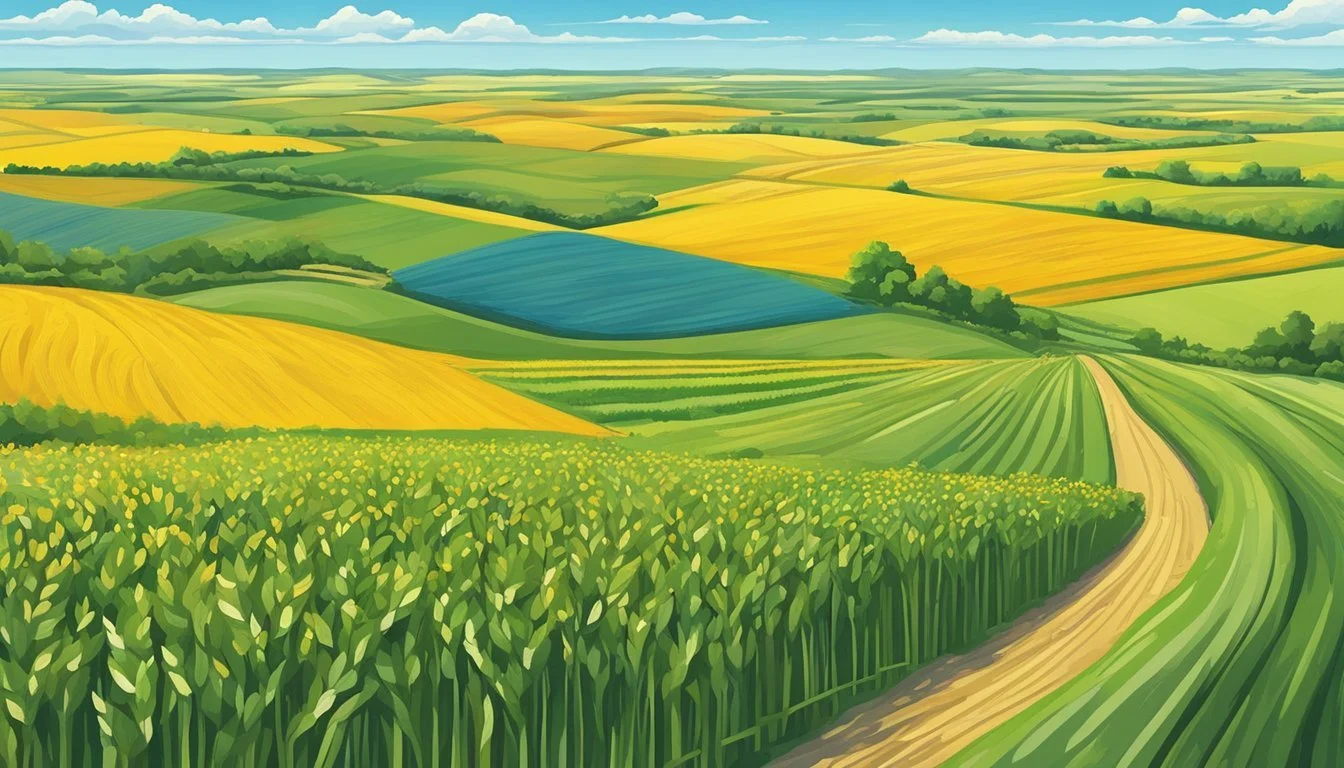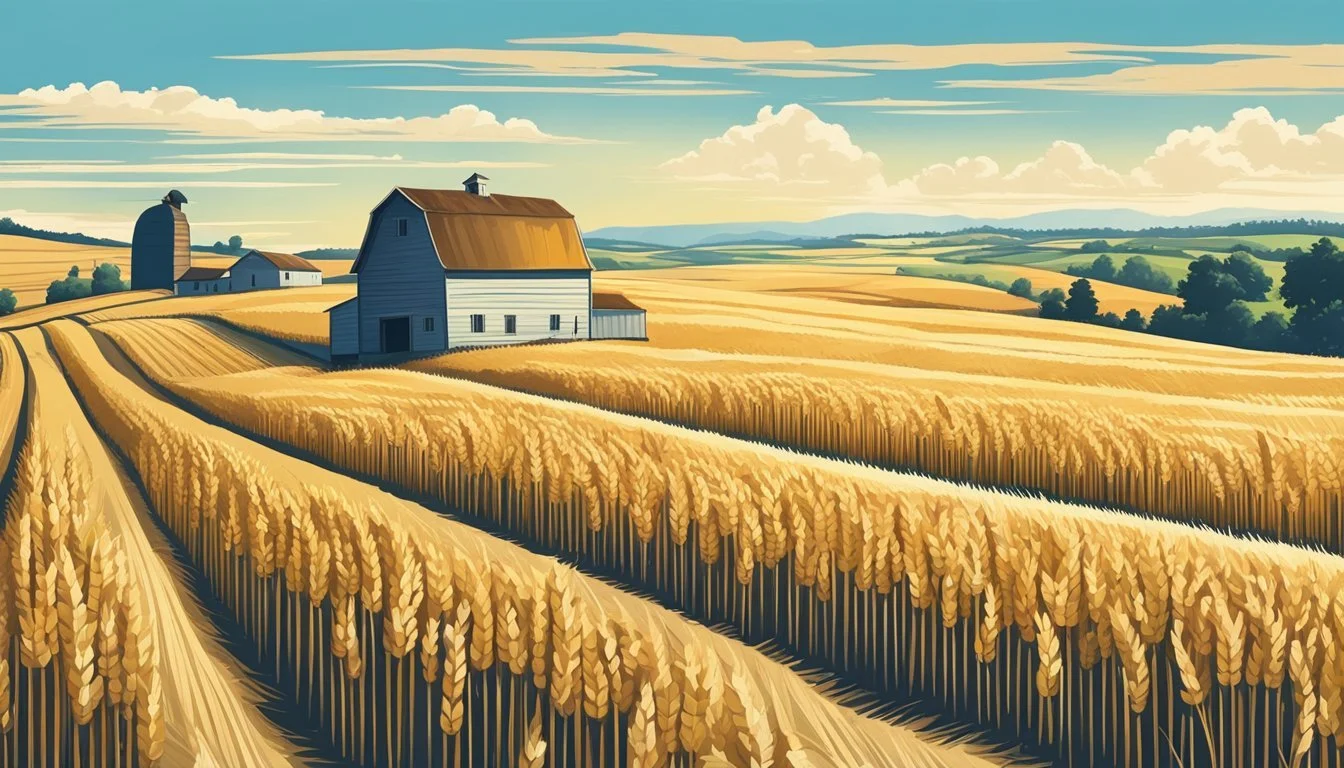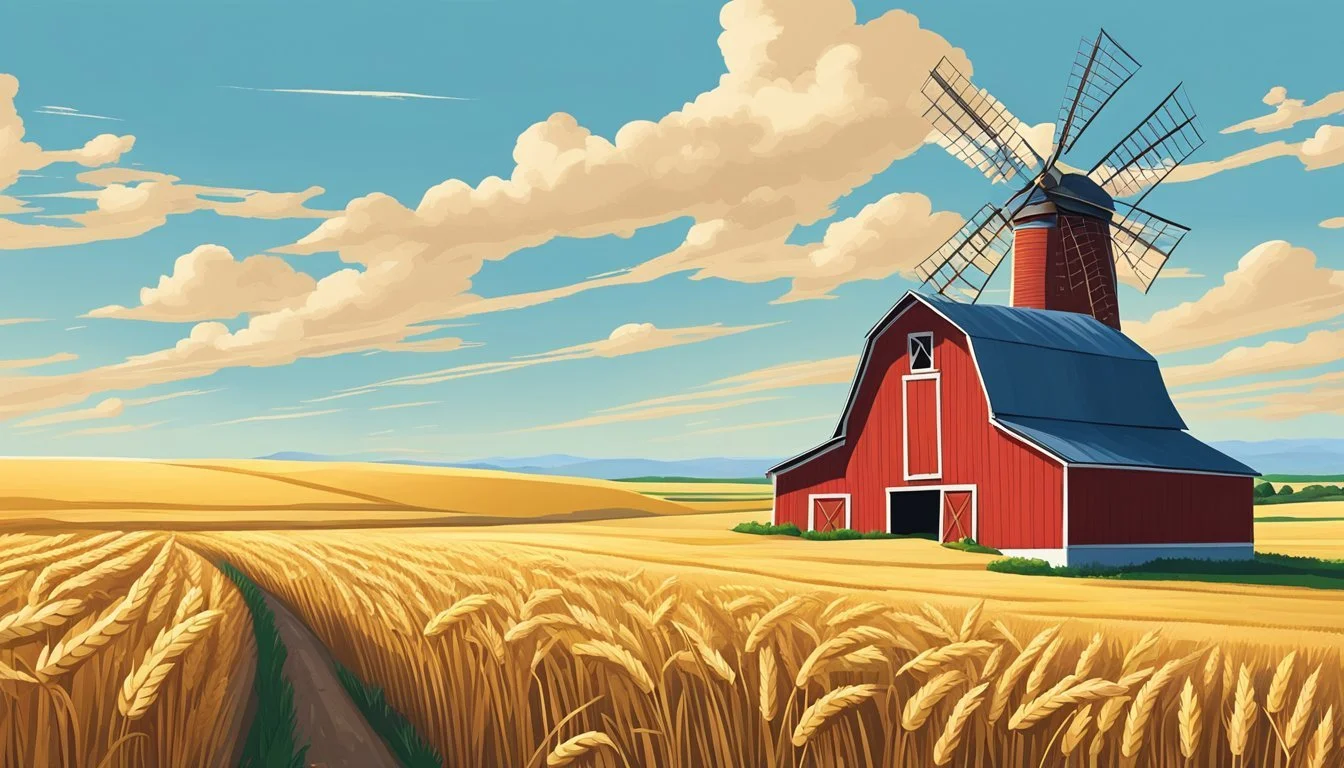Guide to Farming in North Dakota
Essential Tips for Successful Agriculture
This Article is Part of Our State by State Farming Guide
Farming is the backbone of North Dakota, with agriculture playing a pivotal role in the state's economy and cultural heritage. Spread across 39.3 million acres, nearly 90% of the state’s land area is dedicated to agriculture, making it a key player in American and global food production. The average farm in North Dakota spans about 1,512 acres, showcasing the vastness of the agricultural landscape and the commitment of its farmers to cultivating a diverse array of crops and raising livestock.
North Dakota stands out for its production of spring and durum wheat, but it's also a leading producer of a variety of other commodities such as dry edible beans, canola, flaxseed, pinto beans (how long does pinto beans last?), and honey. These products not only serve the domestic market but also play a significant role in international trade. Alongside crop farming, the state is home to robust livestock farming, with beef cattle and swine being prominent.
The state leverages technology and innovative farm management practices to stay at the forefront of agriculture. Both traditional farming techniques and precision agriculture coexist in North Dakota, ensuring efficiency, sustainability, and productivity. With resources like North Dakota State University's Extension services, farmers in the state have access to cutting-edge research and educational programs to continually enhance their farming operations and market understanding.
The History of Agriculture in North Dakota
Agriculture has long been the backbone of North Dakota's economy. As of 2018, North Dakota was one of the nation's top producers of wheat, canola, and various other crops, confirming its critical role in American agriculture.
In the late 19th century, homesteading laws paved the way for settlers, with agriculture blooming soon after. The state's vast prairies offered fertile soil, which, coupled with hardy wheat variants, allowed farmers to thrive despite harsh winters.
Key Developments:
1880s-1890s: Introduction of hardy wheat varieties and extensive railroads.
Early 1900s: Advancements in farming techniques and machinery.
1970s-1980s: Economic difficulties highlight North Dakota’s tie to global markets.
Modern Era: Focus on technological integration and sustainable practices.
The state has faced its share of economic challenges. The 1970s and 1980s were particularly difficult, demonstrating the volatility of reliance on a global agricultural economy. Despite this, North Dakota's farmers have continually adapted, integrating modern techniques and technology to maintain their crops and herds.
By 2018, agriculture in North Dakota had evolved dramatically from its homestead roots. Farmers leveraged technology for precision agriculture, improving efficiency and production. The state noted significant contributions to both the national and international food supply, underscoring its vital role in the agricultural sector.
Contemporary Farming Practices
In North Dakota, farmers and ranchers are increasingly leveraging technology in farming practices to enhance productivity, manage resources efficiently, and ensure sustainable management of crops and livestock.
Technological Advancements in Agriculture
Advances in technology have significantly reshaped agriculture in North Dakota. Farmers utilize drones for monitoring crop health and irrigation systems. Precision farming techniques have become prevalent, relying on satellite technology to develop detailed field maps and guide machinery. These maps assist in planting, irrigating, and harvesting, improving efficiency.
Sustainable Farming and Soil Management
Sustainable practices such as crop rotation bolster soil fertility and diminish disease and pest cycles. Soil management is a key concern, with emphasis on maintaining soil health through cover cropping and minimal tillage. These methods help conserve North Dakota’s natural resources.
Crop Protection and Pesticide Use
In terms of crop protection, farmers deploy a mix of pesticides including herbicides like dicamba and chlorpyrifos to tackle pests and manage cercospora leaf spot. Strategic weed control is outlined in the state's weed control guide, with practices aimed at preventing resistance.
Livestock Rearing and Management
With respect to livestock, North Dakota ranchers raise cattle, sheep, and bison (What wine goes well with bison?), focusing on sustainable grazing and animal health. Ranchers use modern technologies for monitoring animal wellbeing and ensuring high quality produce.
Safety Measures and Dealing with Disasters
Farm safety is paramount to protect both workers and operations. North Dakota’s farmers prepare for natural disasters including droughts and storms, by developing comprehensive emergency plans, which include safeguarding livestock and ensuring continuity of food supply chains.
North Dakota's Key Crops and Commodities
North Dakota is a powerhouse in the United States for various crops and commodities, leading in the production of several grains, oilseeds, legumes, and specialty products.
Cereal and Grain Production
North Dakota's agriculture thrives on its cereal and grain production, with significant contributions to the national supply. The state prides itself on being a leader in the cultivation of spring wheat and durum wheat, both vitally important for pasta and bread production. Other notable small grains include barley and oats, which serve as essential feed for livestock and have applications in food products for human consumption.
Key Grains:
Spring Wheat: 53% of U.S. production
Durum Wheat: 53% of U.S. production
Barley: Used for malting and feed
Oats: Rolled oats (how long do rolled oats last?) for consumer products
Oilseed and Legume Cultivation
Canola accounts for a staggering 85% of the U.S. production, stemming mostly from North Dakota. The state also excels in soybean production, becoming a significant source for both domestic and export markets. Flax, an oilseed high in omega-3 fatty acids, is predominantly harvested here, comprising 82% of the nation's output. Additionally, sunflowers for oil and non-oil use garnish the state's landscape, contributing to 40% of U.S. sunflower production.
Prominent Oilseeds and Legumes:
Canola: 85% of U.S. production
Soybeans: Essential for oil and meal
Flax: 82% of U.S. production
Sunflowers: 40% (oil and non-oil combined) of U.S. production
Specialty Crops and Other Agriculture
North Dakota's agricultural portfolio is diverse, featuring a variety of specialty crops. It leads in the production of dry edible beans, encompassing varieties like pinto beans, Great Northern beans, and black beans. Lentils and dry peas form a significant part of the legume family that the state specializes in. The state has also carved out a niche in honey production, boasting 22% of U.S. production. Innovative sectors like hops and wine production, along with traditional ones like potatoes and sugarbeets, contribute to the local food narrative and the state’s agricultural economic strength.
Specialty Crops:
Dry Edible Beans: No. 1 in pinto and black beans
Honey: 22% of U.S. production
Potatoes and Sugarbeets: Staple crops contributing to the food industry
Agricultural Education and Research
Agricultural education and research in North Dakota are fundamental components in supporting the state's robust agricultural sector. Education programs establish a deep understanding of agricultural sciences, while research initiatives drive innovation and sustainable farming practices.
Institutions and Organizations
North Dakota State University (NDSU) stands at the forefront of agricultural education, offering degrees and research opportunities in various agricultural disciplines. Courses range from crop and animal sciences to agribusiness and food systems, equipping students with comprehensive knowledge and practical skills. NDSU operates research extension centers, such as those in Carrington and Grand Forks, which serve as hubs for agricultural experimentation and extension services.
Organizations such as Future Farmers of America (FFA) and 4-H play a crucial role in youth development and education in agriculture. They provide programs that foster an understanding of farming and cultivate leadership skills in the context of agricultural communities.
The Agriculture Commissioner of North Dakota oversees regulatory responsibilities and promotes agricultural growth and education throughout the state.
Advancements in Agriculture Research
Research initiatives in North Dakota are consistently pushing the boundaries of agricultural knowledge. NDSU's research has focused on addressing local and global challenges, such as pest management, soil health, and water conservation.
Grand Forks is known for research in nutrition and health, adding to the wide array of advancements propelled by NDSU and its affiliates.
Carrington extends its research to crop variety testing and livestock management, ensuring that information is not just theoretical but also applicable and beneficial for the state's unique climate and soil conditions.
These research efforts not only advance scientific understanding but also translate into practical applications that support the state's farmers and the global agricultural community.
Agriculture-Related Economy and Tourism
In North Dakota, agriculture forms the backbone of the local economy, with tourism emerging as an integral component, showcasing the state's rich farming heritage and contributing to economic growth.
Agricultural Economy and Market Trends
North Dakota's agricultural economy is marked by its leadership in the production of several commodities. The state excels in producing:
53% of spring wheat
85% of canola
82% of flaxseed
57% of pinto beans
These crops contribute significantly to the state's economy and are crucial to the ethanol and fuel industries, augmenting the state's energy resources. The trends in market demands and price indices for North Dakota's commodities are instrumental in guiding local farming strategies and economic planning.
Agritourism and Local Marketplaces
Agritourism in North Dakota capitalizes on its strong agricultural roots by inviting tourists to experience the authentic farm life. The sector supports local marketplaces, including:
Pride of Dakota: A program promoting local artisans, which includes food producers, increasing the visibility of homegrown products.
Farmers Markets: Regular markets where locals can buy fresh, locally-produced goods directly from the farmers.
This connection between agriculture and tourism not only enhances the visibility of North Dakota's agricultural products but also contributes to the state's tourism-related revenue.
Job Creation and the Role of Engineers
The fusion of agriculture and technology in North Dakota has led to new job opportunities, especially for engineers. With the North Dakota Mill and the advancing agritourism sector, the demand for professionals who can introduce innovative solutions and enhance efficiency in agricultural production is high. Engineers play a pivotal role in developing agricultural machinery, ethanol production facilities, and maintaining the infrastructure that supports both the tourism and agricultural sectors. This synergy is vital for continued economic development and job creation within the state.
Cultural Significance and Historical Sites
North Dakota's farming legacy is not only foundational to its economy but also to its cultural identity, with historic sites and community events celebrating the state's agricultural past.
Agricultural Heritage and Community Events
The Pride of Dakota program exemplifies North Dakota's commitment to its agricultural roots, fostering a sense of community while promoting local producers. Farming communities, such as Rutland, host events like Uffda Day, which showcase Slavic heritage through traditional foods and crafts. Valley City's Agriculture Hall of Fame at the Rosebud Visitor Center provides in-depth displays on regional crops and livestock, highlighting how North Dakota farms contribute to global food supply.
Historical Farms and Education Centers
Bagg Bonanza Farm in Mooreton is among the most significant historical sites, as it stands as a testament to the large-scale wheat farming that characterized the early 1900s. This bonanza farm has been preserved to educate visitors on its impact. Crooked Lane Farm Folk School in Colfax further serves as an educational center where traditional farming techniques and local history are taught, illustrating the historical interplay between agriculture and community development.
Innovative Approaches to Diversification
In response to changing markets, North Dakota farms have employed diversification strategies. Vineyards such as Red Trail Vineyard near Mandan and Buffalo Trail Vineyard have emerged, showcasing innovative agricultural methods while adding to tourism attractions. Farm diversification extends to historic restoration as well, with venues like Washburn's Lewis and Clark Interpretive Center intersecting historical tourism with agricultural history.
Environmental Conservation and Land Use
In North Dakota, the integration of environmental conservation within agricultural land use is paramount. The state's farmers and ranchers are recognized for their commitment to stewardship, employing practices aimed at preserving natural resources—soil, water, and air—while facilitating sustainable production.
Agricultural land predominantly constitutes cropland, dedicated to growing crops. Conservation efforts focus on maintaining soil health and mitigating the challenges of a wet fall, an event that complicates harvesting and soil management. Techniques such as no-till farming and crop rotation are employed to preserve the soil structure and prevent erosion.
Wetland conservation is another critical aspect of North Dakota's agricultural land use, with wetlands serving as vital ecological areas that support biodiversity and water filtration. The conservation plans include:
Wetland Preservation
Safeguarding existing wetlands against drainage and ensuring their natural functions are maintained.Buffer Zones
Establishing vegetated areas around wetlands to reduce runoff and non-point source pollution.
Natural resource conservation services offer scientific and technical assistance to landowners, aiming to balance land productivity with environmental health. Practices adopted across the state reflect an understanding that the well-being of agriculture is inextricably linked to the conservation of the resources that support it.
North Dakota's Agricultural Future
As North Dakota's farmers look towards the future, they grapple with fluctuating profit projections and the ever-present challenge of climate change. The commitment to embracing new crop varieties, adjusting to policy changes, and integrating renewable energy underscores their resilience and adaptability.
Emerging Trends and Crop Varieties
Farmers in North Dakota are exploring a diverse range of crops beyond the traditional staples. Interest in dry edible beans, such as pinto and great northern beans, is on the rise, accounting for significant portions of national production. Flaxseed and honey also feature prominently in state outputs. The changing climate patterns drive farmers to adapt with new crop varieties that are more drought-resistant and mature faster, ensuring sustainability.
Key crops with increased interest:
Dry edible beans
Flaxseed
Honey
Focus for future sustainability:
Drought-resistant varieties
Faster maturing crops
Policy and Regulatory Considerations
Regulatory frameworks guide the agricultural industry, affecting everything from crop insurance to land use. North Dakota's farmers must stay informed on policies regarding fertilizer usage and conservation practices to ensure compliance and operational efficiency. With the 2024 crop budgets in mind, farmers are directed by large multicounty region guides, which aid in planning for projected profits and expenditures.
Policies impacting farming:
Crop insurance regulations
Conservation practices
Fertilizer application standards
The Role of Renewable Energy in Agriculture
Renewable energy plays a crucial role in the advancement of North Dakota's agricultural sector. The state is seeing an increase in the use of wind and solar power on farms, reducing dependence on traditional energy sources and minimizing environmental impact. The integration of these technologies not only supports the long-term viability of farming operations but also contributes to overall state goals for clean energy.
Renewables gaining traction:
Wind turbines
Solar panels
Benefits of renewable integration:
Reduced energy dependence
Lower environmental impact








